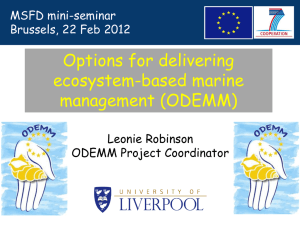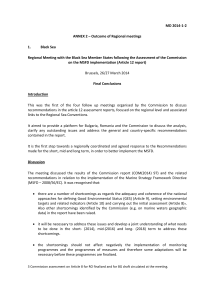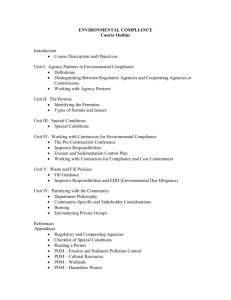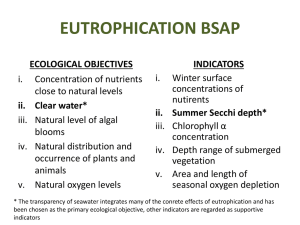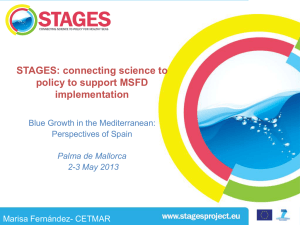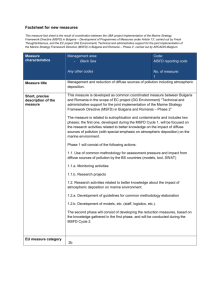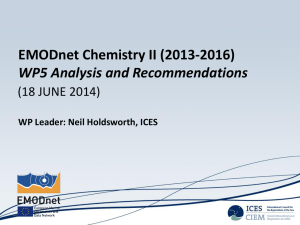MSFD Art.13 Programmes of measures - reporting concept
advertisement
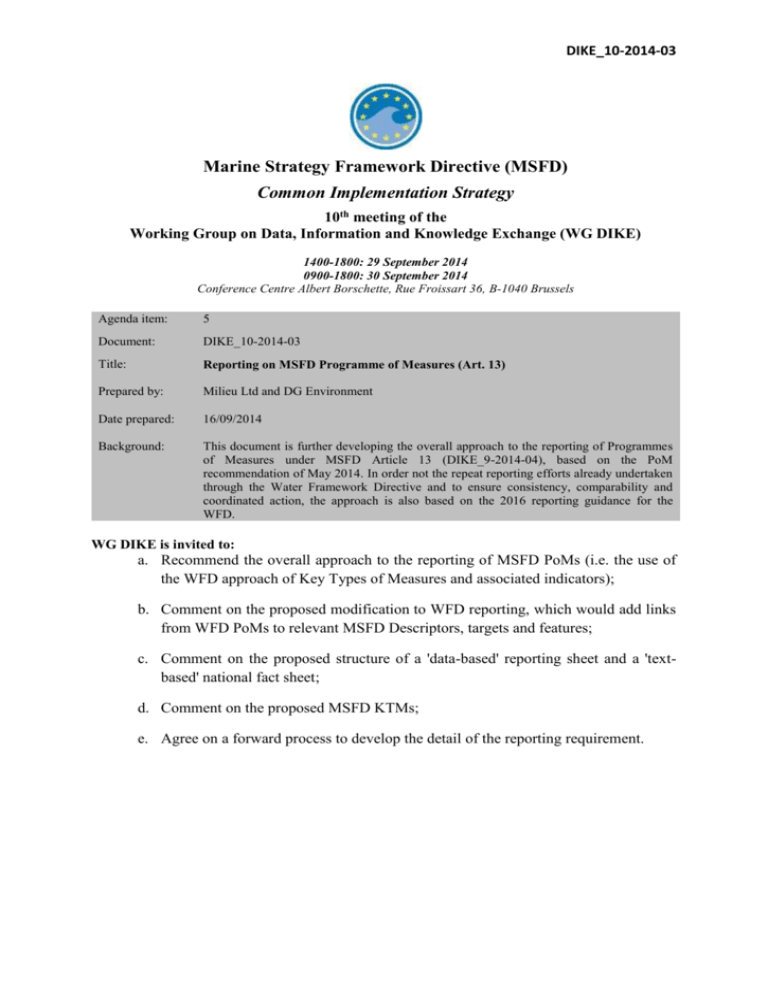
DIKE_10-2014-03 Marine Strategy Framework Directive (MSFD) Common Implementation Strategy 10th meeting of the Working Group on Data, Information and Knowledge Exchange (WG DIKE) 1400-1800: 29 September 2014 0900-1800: 30 September 2014 Conference Centre Albert Borschette, Rue Froissart 36, B-1040 Brussels Agenda item: 5 Document: DIKE_10-2014-03 Title: Reporting on MSFD Programme of Measures (Art. 13) Prepared by: Milieu Ltd and DG Environment Date prepared: 16/09/2014 Background: This document is further developing the overall approach to the reporting of Programmes of Measures under MSFD Article 13 (DIKE_9-2014-04), based on the PoM recommendation of May 2014. In order not the repeat reporting efforts already undertaken through the Water Framework Directive and to ensure consistency, comparability and coordinated action, the approach is also based on the 2016 reporting guidance for the WFD. WG DIKE is invited to: a. Recommend the overall approach to the reporting of MSFD PoMs (i.e. the use of the WFD approach of Key Types of Measures and associated indicators); b. Comment on the proposed modification to WFD reporting, which would add links from WFD PoMs to relevant MSFD Descriptors, targets and features; c. Comment on the proposed structure of a 'data-based' reporting sheet and a 'textbased' national fact sheet; d. Comment on the proposed MSFD KTMs; e. Agree on a forward process to develop the detail of the reporting requirement. DIKE_10-2014-03 Concept note on the reporting and assessment of the MSFD Programme of Measures Draft outline 15 September 2014 Version 3 DIKE_10-2014-03 DISCLAIMER: The opinions expressed in this document are the sole responsibility of the authors and do not represent the official position of the European Commission. The main authors of this report are Jan Cools, Bastiaan Vermonden, Alice Belin and Claire Dupont (Milieu Ltd). Milieu Ltd. (Belgium), 15 rue Blanche, B-1050, Brussels, tel: 32 2 506 1000; Fax 32 2 514 3603; email: claire.dupont@milieu.be and alice.belin@milieu.be; web address: www.milieu.be DIKE_10-2014-03 Contents Section 1. Objective of this concept note ................................................................................................ 5 Section 2. Setting the scene ..................................................................................................................... 6 2.1 The PoM recommendation ............................................................................................................ 6 2.2 Typology of measures ................................................................................................................... 8 Section 3. Conceptual approach for the MSFD PoM reporting ............................................................ 10 3.1 Adopting WFD reporting to MSFD reporting needs ................................................................... 10 3.2 Proposed Key Types of Measures for MSFD.............................................................................. 13 3.3 Member States’ text-based country fiche/factsheet for public consultation and assessment ...... 14 Section 4 Article 16 Assessment ........................................................................................................... 16 Tables Table 1 Categories of measures based on PoM recommendations.......................................................... 6 Table 2 Modes of action of PoM recommendation ................................................................................. 8 Table 3 Typology for the MFSD measures as described in Annex VI MSFD ........................................ 9 Table 4 Typology of KTMs for the 2016 WFD reporting ..................................................................... 10 DIKE_10-2014-03 Section 1. Objective of this concept note According to Article 5(2)(b) of the Marine Strategy Framework Directive (MSFD), Member States should develop a Programme of Measures (PoM) by 2015 latest and notify the European Commission of their PoM within three months (Article 13(9)). The Commission will undertake an assessment of the Member States' PoMs (Article 16) and provide guidance to the Member States on these within six months of receiving all these notifications. The assessment is expected to be presented in the form of national and regional assessment reports, as was done for the Article 12 assessment in 2014. This concept note is based on the provisions of the MSFD and the document entitled “Programmes of measures under MSFD – Recommendations for establishment/implementation and related reporting” (hereafter called “PoM recommendation”), as discussed at the Marine Strategy Coordination Group (MSCG) and the Marine Directors meetings in May and June 20141. The “PoM recommendation” outlines the process towards the development of a PoM by each Member State. As stated in the recommendation document, the process starts by the identification of existing measures that are relevant for the MSFD. A gap analysis is then done which is followed by the identification and selection of new measures to be applied under the MSFD (after a feasibility study and cost benefit analysis). Exceptions are then assessed and, if applicable, justified. A draft PoM is issued and then finalised after a public consultation process (Figure 1). In view of the principle to streamline reporting and thus avoid duplication of work, the reporting on PoM under the MSFD does not need to contain the information which has already been reported under the Water Framework Directive (WFD). To streamline the process, the PoM reporting content is to be closely linked with that of the WFD and corresponding reporting requirements. A factor that allows this close coordination of the reporting efforts under the WFD and the MSFD is the timing of reporting for both directives which coincide and are only days apart in March 2016. In preparation for the reporting exercise, this concept note aims to: Support the development of the reporting questions for the PoM (art. 13) and exceptions (art. 14) under the MSFD; Build upon the reporting framework already in place under other European policies, specifically the WFD; Provide a basis for the discussion on the final products that will be derived from this reporting and the assessment questions needed for the Commission's Art. 16 assessment. In the sections that follow, this paper first sets the scene (Section 2) by explaining the approach of the work which utilises elements from the “PoM recommendation”, the existing typologies for measures in other European Directives, the categories present in the Annex VI of the MSFD as well as the "WFD reporting guidance 2016"2 that provides guidance to the design of the assessment and reporting questions for the PoM and exceptions reporting under the MSFD. In the second part (Section 3), the report presents the conceptual approach for the reporting on MSFD PoM with a two-step approach: - reporting of data and numerical information in reporting sheets, building on the existing WFD reporting framework, and extending to accommodate MSFD-specific measures - reporting of qualitative and textual information to provide explanations and justifications in relation to the PoM and with a view to this being submitted to public consultation Finally, Section 4 presents first indicative headline questions to be used for the Article 16 Assessment of the Commission. 1 The version used for this concept note is version 13 of 27 May 2014 ADD Web LINK Discussed during the WFD SCG meeting of May 2014 and further updated on 9 July 2014 https://circabc.europa.eu/w/browse/0467f5e1a4a2-464c-8fff-59a0826567b8 2 Milieu Ltd Consortium September 2014 Support to the implementation of the MSFD / 5 Draft Concept for Technical Assessment of PoM & exceptions DIKE_10-2014-03 Section 2. Setting the scene 2.1 The PoM recommendation The PoM recommendation defines a Programme of Measures (PoM) as “a set of measures that the MS is responsible for implementing, put into context with each other and referring to the environmental targets they address”. The Programme of Measures includes existing and new measures. Four categories of measures have been defined in the PoM recommendation (Table 1). Table 1 Categories of measures based on PoM recommendations Measures Measure category Costeffectiveness analysis (CEA) Costbenefit analysis (CBA) Article 13.1 & 13.2 Measures relevant for the maintenance and achievement of GES under the MSFD that have been adopted under other policies and implemented EXISTING 1.a No No Article 13.1 & 13.2 Measures relevant for the maintenance and achievement of GES under the MSFD that have been adopted under other policies but that have not yet been implemented or fully implemented EXISTING 1.b No No Art 13.3 Additional measures to achieve GES which build on existing EU legislation and international agreements but go beyond what is already required under these NEW 2.a Yes* Case by case Yes* Case by case Art 13.3 Additional measures to achieve GES which do not build on existing EU legislation or international agreements, i.e. that are completely new. NEW 2.b Yes Yes Source: adapted from “POM recommendation” The content of the PoM and the process to develop them is described in the PoM recommendation. Figure 1 shows the process. It follows from the logic of the Directive that the starting point for the programme of measures is the environmental targets, provided that they are set in an adequate and coherent way, i.e. they address the key pressures which are preventing the achievement of GES (see Art. 12 report3). In order to identify the need for new measures for achieving or maintaining GES, Art. 13 of the MSFD spells out some requirements for the identification and selection of individual measures and for establishing the programme of measures. 3 http://ec.europa.eu/environment/marine/eu-coast-and-marine-policy/implementation/reports_en.htm Milieu Ltd Consortium September 2014 Support to the implementation of the MSFD / 6 Draft Concept for Technical Assessment of PoM & exceptions DIKE_10-2014-03 Inventory of existing measures * Towards GES, targets, and reduction of pressures Gap analysis Measures which are technically feasible, cost-effective and sustainable. Identification and selection of new measures Application of exceptions? NO YES Article 14 application Identification of cases. Justification of exceptions. Identification of ad-hoc measures. Draft PoM Public Consultation Final PoM Figure 1 Overview of the process for the development of a Programme of Measures and the identification of exceptions (*) Existing measures are considered to be all measures currently implemented and those which are going to be implemented as planned under EU legislation other than the MSFD (e.g. WFD, HBD) and/or international agreements. The content of the PoM, following the PoM recommendation, shall include: An overview of the existing measures (categories 1.a and 1.b) with reference to their original publication; A short analysis of the contribution and expected future contributions of existing measures, including measures for which implementation has not started or is on-going, towards Milieu Ltd Consortium September 2014 Support to the implementation of the MSFD / 7 Draft Concept for Technical Assessment of PoM & exceptions DIKE_10-2014-03 achieving and maintaining GES (baseline) and the gap that needs to be addressed (gap analysis); For category 2.a measures, brief details are to be described to the document containing a more extensive description (e.g. WFD PoM) together with full details on the additional aspects that are needed to achieve the MSFD GES and targets; For category 2.b measures, which have not been published elsewhere, a full description is to be given under the MSFD reporting sheet; Justification for exceptions, where measures will be insufficient to achieve GES. The summary for the new measures shall include: Method for selecting measures, Implementation (e.g. by legal, policy, socio-economic and financial instrument), including overview of co-financed measures (art. 22) where relevant, Identification of spatial protection measures and the purpose for which they are put in place (e.g. contributing to coherent and representative networks of marine protected areas art. 13.4), Cost-effectiveness and/or cost benefits of the measures (how it has been taken into account?) and sustainability (art. 13.3), Overall coordination or input to other EU legislation and policies (including international agreements), Overall regional coordination including possible impacts on the marine waters of other countries (art. 13.8), Public consultation information. 2.2 Typology of measures Various typologies of PoMs for reporting and implementation purposes are available and may be relevant to MSFD PoMs: a. The four modes of action described in the PoM recommendation (Table 2) Table 2 Modes of action of PoM recommendation ‘Technical’: an actual action that one can see (and measure) in the field. In principle a wide range of measures have a primarily technical mode of action. ‘Legislative’: Adapting or supplementing national environmental law and other national legislation influencing the marine environment to implement environmental targets and to achieve/maintain GES. ‘Economic’, such as economic incentives that provide financial motives to stimulate a desired behaviour or discouraging an unwanted behaviour. Financial instruments are often aimed at the uptake of technical measures. For example, a subsidy for beach resorts of 20 Euros for each additional garbage bin they place. ‘Policy driven’: Policy instruments can be economic incentives, but also other instruments, such as voluntary agreements with stakeholders, communication strategies, awareness raising, and education. For example, the government launches an information campaign to make the beach resorts aware of the new subsidy they can get for placing more garbage bins, or beach resorts informing their customers where the litter bins are located, or teachers telling children it is fun to collect waste and put it in a litter bin and gives you a clean beach as well. b. The categories of Annex VI MSFD (Table 3) These categories may be useful for EU-level communication. Milieu Ltd Consortium September 2014 Support to the implementation of the MSFD / 8 Draft Concept for Technical Assessment of PoM & exceptions DIKE_10-2014-03 Table 3 Typology for the MFSD measures as described in Annex VI MSFD N° Description of measure 1 4 Input controls: management measures that influence the amount of a human activity that is permitted. Output controls: management measures that influence the degree of perturbation of an ecosystem component that is permitted. Spatial and temporal distribution controls: management measures that influence where and when an activity is allowed to occur. Management coordination measures: tools to ensure that management is coordinated. 5 Measures to improve the traceability, where feasible, of marine pollution 6 Economic incentives: management measures which make it in the economic interest of those using the marine ecosystems to act in ways which help to achieve the good environmental status objective. Mitigation and remediation tools: management tools which guide human activities to restore damaged components of marine ecosystems. Communication, stakeholder involvement and raising public awareness. 2 3 7 8 c. The typologies used in the WFD and the Habitats Directive The WFD and the Habitats Directive use different typologies to report on measures. These typologies vary considerably. The WFD uses a set of 25 Key Types of Measures (KTM), many of which are highly relevant for the MSFD reporting. For the 2016 reporting of the WFD, KTMs have been predefined, based on the KTMs defined for the 2012 progress reports on the implementation of the programme of measures, the new ones reported by Member States in 2012 and commonly reported significant pressures not previously incorporated by predefined KTMs. Under the WFD, there is no explicit linkage to the Habitats Directive, even though many WFD measures are assumed to have a positive benefit for the Habitats Directive as well. The typology for conservation measures under the Habitats Directive is made up of nine measures, which are thematic. All categories of measures are relevant for the marine environment, either directly (i.e. measures related to coastal habitats, measures related to marine habitats, measures for fishing, measures related to marine spatial planning,) or indirectly (i.e. measures on freshwater and forests). Elements of these measures have been used in the development of MSFD KTMs (see Section 3). Milieu Ltd Consortium September 2014 Support to the implementation of the MSFD / 9 Draft Concept for Technical Assessment of PoM & exceptions DIKE_10-2014-03 Section 3. Conceptual approach for the MSFD PoM reporting In order not to repeat reporting efforts already undertaken through the WFD, and to ensure consistency, comparability and coordinated action, the proposed approach for the development of the reporting questions for the MSFD PoM is to build upon the existing WFD reporting framework and its KTMs. The work is three-fold, and consists of: - examining and introducing any necessary additional questions relating to the MSFD into the WFD reporting sheets (and its 25 WFD KTMs); - developing an additional set of MSFD-focused KTMs and related reporting questions for any measures that are not being already covered by the WFD; - developing a set of more general reporting questions, following the outline provided in the PoM recommendation, which describe the overall approach, considerations and limitations of the PoM. The questions for reporting on the MSFD KTMs will be similar to those under the WFD, and will be made up of a set of questions with pre-defined numeric answers that will produce data-based reporting sheets. Additionally, a second reporting tool will be a text-based reporting template/country fiche that the MS will use to further explain and illustrate their KTMs implemented in relation to the MSFD (the outline/table of contents of this text-based report is presented in section 3.3). Together, these two reports will constitute the reporting package of Article 13. Member States MSFD reporting Data-based Text-based Reporting sheets Country fiches 3.1 Adopting WFD reporting to MSFD reporting needs The reporting of measures under the WFD KTMs in 2016 is expected to make a significant contribution to achieving GES for the MSFD, especially to address land-based pressures which are also affecting the marine environment. There is a need to add some "new" KTMs which are focused on sea-based (and air-based) pressures in order to cover any new MSFD-specific measures. This extension to the existing WFD approach will facilitate comparability and the consolidation of information at the EU level. Member States are expected to "bundle" their national measures (usually much more detailed than the KTMs) to report them in an aggregated way as KTMs. Quantitative indicators are reported at the level of KTMs. The 25 predefined KTMs for the 2016 WFD reporting, as well as their relevance to MSFD, are listed in Table 4. Table 4 Typology of KTMs for the 2016 WFD reporting N° 1 WFD KTM description Construction or upgrades of wastewater treatment plants 2 Reduce nutrient pollution from agriculture Milieu Ltd Consortium September 2014 Relevance to MSFD Yes - relevant for the reduction of nutrient loads & solid particles (D5, D10) Yes - relevant for the reduction of nutrient loads (D5) Support to the implementation of the MSFD / 10 Draft Concept for Technical Assessment of PoM & exceptions DIKE_10-2014-03 N° 3 WFD KTM description Reduce pesticides pollution from agriculture. 4 Remediation of contaminated sites (historical pollution including sediments, groundwater, soil). 5 Improving longitudinal continuity (e.g. establishing fish passes, demolishing old dams). Improving hydromorphological conditions of water bodies other than longitudinal continuity (e.g. river restoration, improvement of riparian areas, removal of hard embankments, reconnecting rivers to floodplains, improvement of hydromorphological condition of transitional waters, etc.). Improvements in flow regime and/or establishment of ecological flows. Water efficiency technical measures for irrigation, industry, energy and households Water pricing policy measures for the implementation of the recovery of cost of water services from households Water pricing policy measures for the implementation of the recovery of cost of water services from industry Water pricing policy measures for the implementation of the recovery of cost of water services from agriculture Advisory services for agriculture 6 7 8 9 10 11 12 13 14 15 16 Drinking water protection measures (e.g. establishment of safeguard zones, buffer zones etc.) Research, improvement of knowledge base reducing uncertainty. Measures for the phasing-out of emissions, discharges and losses of priority hazardous substances or for the reduction of emissions, discharges and losses of priority substances. Upgrades or improvements of industrial wastewater treatment plants (including farms) 17 Measures to reduce sediment from soil erosion and surface run-off 18 Measures to prevent or control the adverse impacts of invasive alien species and introduced diseases Measures to prevent or control the adverse impacts of recreation including angling Measures to prevent or control the adverse impacts of fishing and other exploitation/removal of animal and plants Measures to prevent or control the input of pollution from urban areas, transport and built infrastructure 19 20 21 22 Measures to prevent or control the input of pollution from forestry 23 Natural water retention measures 24 Adaptation to climate change 25 Measures to counteract acidification Milieu Ltd Consortium September 2014 Relevance to MSFD Yes - relevant for the reduction of contaminants loads (D8, D9) Possibly relevant for the reduction of contaminants loads (D8, D9) Possibly relevant in relation to diadromous fish (D1) Yes - relevant (D7) Unlikely Unlikely Unlikely Unlikely Unlikely Maybe relevant for nutrient and pesticide reduction (D5, D8 and D9) Unlikely Could be applied to all descriptors Yes relevant for the reduction of contaminant loads (D8, D9) Yes - relevant for the reduction of nutrient, solid particles and contaminant loads (D8, D9, D10) Possibly relevant for the reduction of nutrients & sediments (D5, D7) Yes - relevant (D2) Yes - relevant (D3, D10, D11) Yes - relevant (D1,D3, D4, D6) Yes - relevant for the reduction of pollution in general (D5, D8, D9, D10, D11) Possibly relevant for the reduction of nutrient and contaminant loads (D5, D8, D9) Unlikely Yes relevant, in particular when related to the coastal zone (D1, D4, D6, D7) Possibly relevant to ecosystembased descriptors (D1, D3, D4, D6) Support to the implementation of the MSFD / 11 Draft Concept for Technical Assessment of PoM & exceptions DIKE_10-2014-03 The 2016 WFD reporting guidance already includes linkages to the MSFD by means of new reporting questions that cover the MSFD. These are listed in the textbox below. Questions related to MSFD in the 2016 WFD reporting on measures: Is this measure relevant for the purpose of the Marine Strategy Framework Directive? Has the preparations of the WFD RBMP/PoM been coordinated with the implementation of the Marine Strategy Framework Directive? In developing the WFD PoM, have you assessed the need for additional measures/more stringent measures beyond those required by the WFD in order to achieve the relevant MSFD objectives in coastal and marine environment? If MSFD Assessment is “yes”, for which issues are additional measures needed to meet the MSFD objectives? Choice is given between Nutrients, chemicals, litter, others Please provide a reference to where more information can be found on the coordination with the MSFD implementation and the consideration of the MSFD objectives in developing the WFD PoM. Was joint consultation carried out on the Marine Strategy? If yes, provide more information in the RBMP/background documents. Three additional questions are proposed to be added in the WFD reporting system that will contribute necessary information to the MSFD reporting and allow to fully use the reporting process under the WFD. These three additional questions could be inserted below the already existing question on MSFD relevance in the section entitled “Mapping KTMs to individual measures”.4 Existing question: Schema element: MSFDRelevance Field type / facets: Yes, No, Unclear Guidance: Required: Is this measure relevant for the purpose of the Marine Strategy Framework Directive? Suggested additional questions: Schema element: MSFDRelevance per Decriptor Field type / facets: List D1, D2, D3, D4, D5, D6, D7, D8, D9, D10, D11 Guidance: Conditional: if answered “yes” to MSDFRelevance question. To which MSFD descriptors does the measure relate to? Quality check: required if reply to MSFDRelevance is Yes 4 p.241 of the WFD 2016 Guidance report Milieu Ltd Consortium September 2014 Support to the implementation of the MSFD / 12 Draft Concept for Technical Assessment of PoM & exceptions DIKE_10-2014-03 Schema element: MSFDRelevance to Annex III Field type / facets: List Enumeration List of Items in for MSFD Annex III reporting Guidance: Conditional: if answered “yes” to MSDFRelevance question. To which MSFD Annex III categories it relates to? Quality check: required if reply to MSFDRelevance is Yes Schema element: MSFDRelevance to targets Field type / facets: List* or String Guidance: Conditional: if answered “yes” to MSDFRelevance question. To which MSFD MS specific targets from Art. 10 report it relates to? Quality check: required if reply to MSFDRelevance is Yes (*) This is provided that a mechanism is in place so that the MSFD targets and related GES can be listed in a standardized and numerical way. 3.2 Proposed Key Types of Measures for MSFD On the basis of the sections above, a preliminary set of KTMs for the MSFD is proposed in Table 5 in addition to the ones already in place under the WFD, taking into account the various elements of Annex III, Table 2 of the MSFD, specifically targeting marine areas. In Table 2 of Annex III of the MSFD most marine pressures are listed in a general sense providing a good starting point for defining the KTMs. A number of additional KTMs would address the additional needs that are not directly related to any specific pressure; these can be found at the bottom of the KTM table. Table 5 Proposed Key Type of Measures (KTMs) for the MSFD. The numbering continues from the WFD KTMs. N° 26 Proposed new KTMs for MSFD reporting Measures to address physical loss of seabed habitats in the marine environment 27 28 Measures to address physical damage to the marine environment Measures to address inputs of energy to the marine environment, including underwater noise Measures to address marine littler Measures to address interferences with hydrological processes in the marine environment Measures to address contamination by hazardous substances (synthetic substances, nonsynthetic substances, radio-nuclides) and the systematic and/or intentional release of substances in the marine environment from sea-based or air-based sources Measures to address nutrient and organic matter inputs to the marine environment from sea-based or air-based sources Measures to address the introduction and spread of non-indigenous species 29 30 31 32 33 34 35 36 37 38 Measures to address biological disturbances in the marine environment from the selective extraction of species including incidental non-target catches Measures to address other types of biological disturbance, including death, injury, disturbance and translocation of marine species, introduction of genetically-modified individuals and introduction of microbial pathogens Measures related to Spatial Protection Measures for the marine environment Economic incentives: management measures which make it in the economic interest of those using the marine ecosystems to act in ways which help to achieve the good environmental status objective. (Annex VI MSFD) Research, improvement of knowledge base reducing uncertainty in the marine environment Milieu Ltd Consortium September 2014 Support to the implementation of the MSFD / 13 Draft Concept for Technical Assessment of PoM & exceptions DIKE_10-2014-03 Based on the new MSFD KTMs a set of reporting sheets in line with the questions of the WFD reporting sheets needs to be developed. Questions in the reporting sheets will address each of the new KTMs and will also cover exceptions. For each of the KTMs a set of indicators will also need to be developed. It is envisaged that the reporting sheets will have a similar format to those for the WFD and the earlier reporting formats under the MSFD, such as developed for the monitoring programmes. 3.3 Member States’ text-based country fiche/factsheet for public consultation and assessment In addition to reporting numerical and statistical data in the WFD (section 3.1) and MSFD-specific reporting sheets (section 3.2), it is proposed that the Member States prepare a text-based “country fiche” which would include qualitative information regarding their PoMs. This text-based report would be used for the purpose of public consultation and communication and would give Member States the opportunity to provide background information and justification on their PoM as well as on the application of exceptions, if relevant. On the basis of the “PoM Recommendation” of May 2014, the following “table of content” (and guiding questions in each section) is proposed for the country fiches/factsheets: General questions 1. For each descriptor and associated targets, has a Programme of Measures been developed? (Y/N) 2. Update of targets a. Did you modify the Environmental Targets after the Art. 12 assessment exercise? If ‘yes’ which targets were modified? b. Did you set any operational targets that relate to concrete implementation measures to support their achievement (Annex IV (2))? 3. For each descriptor and associated targets, did you ensure that the PoM will achieve the environmental targets and GES? 4. Exceptions? (only to be answered if ‘no’ is answered to question 3) a. Do you make use of any exception and if so, for what reasons? b. Inventory of exceptions: Exceptions under 14(1): describe… Exceptions under 14(4): describe… c. In case an exception has been identified, Have the consequences of the exception(s) to the marine region of subregion of concern been addressed? Has the adverse impact of the exception(s) on the marine waters of other Member States been mitigated? Have ad-hoc measures been proposed to continue pursuing targets and GES? Have ad-hoc measures been proposed to prevent further deterioration? Specific questions 5. Inventory of existing measures a. Has an inventory of existing measures under other legislation been undertaken (including Milieu Ltd Consortium September 2014 Support to the implementation of the MSFD / 14 Draft Concept for Technical Assessment of PoM & exceptions DIKE_10-2014-03 b. 6. measures for which implementation is pending or on-going)? Have you assessed to which extent the existing measures are sufficient to achieve GES and environmental targets? Has a gap analysis been made between baseline scenario (i.e. current status taking into account implementation of existing measures) and GES? New measures a. Have new measures been identified to bridge the gap between baseline scenario and the desired status of the marine environment (GES and targets)? b. When selecting new measures have you ensured that they are based on / taken into account: Technical feasibility Impact assessment (environmental, social and economic) Cost-effectiveness analysis Cost-benefit analysis Sustainability, considering the environmental, social and economic impact of new measures Risk on waters beyond their marine waters c. Have you designated marine protected areas covering the relevant biodiversity components? Will the spatial protection measures contribute to a coherent and representative network of marine protected areas covering the relevant biodiversity components? d. Have you taken consideration of maritime spatial planning when designing new measures? Process-related questions 7. Obligations in relation to public consultation (art 19(2)) a. When was the public consultation undertaken? b. Where/How? (consultation website) c. How was it taken into account? 8. Administrative process (art 13(3) and 13(10)) Description of implementation process (together with administrative framework (e.g. the policy tools or plans containing the measures, including new measures, for protecting the marine environment (e.g. WFD PoM, National Waste prevention plans)) Milieu Ltd Consortium September 2014 Support to the implementation of the MSFD / 15 Draft Concept for Technical Assessment of PoM & exceptions DIKE_10-2014-03 Section 4 Article 16 Assessment Article 16 MSFD requires the Commission to make an assessment, within 6 months, of whether the programmes “constitute an appropriate framework to meet the requirements” of the MSFD (Article 16 assessment). This includes assessing the adequacy, consistency and coherence of the information reported by the Member States. In order to guide the Member States on the content of their PoM reporting (Article 13), it is important to also define the questions used to make the assessment of adequacy, consistency and coherence as per Article 16 MSFD. To define these assessment questions, a modular approach similar to that used for the Art. 12 assessment of monitoring programmes is followed, with first a set of headline assessment questions. Where relevant the PoM recommendations have been integrated. A more detailed set of assessment questions on the adequacy, consistency and coherence of the measures reported will then be developed along with the structure of the information that Member States should report in order to allow this assessment. The preliminary set of headline assessment questions are: 1. Has a public consultation been undertaken? 2. Has an inventory of existing measures under other legislation been undertaken (including measures for which implementation is pending or on-going)? 3. Has the MS assessed to which extent the existing measures are sufficient to achieve GES and environmental targets? Has a gap analysis been made between baseline scenario (i.e. current status taking into account implementation of existing measures) and GES? 4. Have new measures been identified to bridge the gap between baseline scenario and the desired status of the marine environment (GES and targets)? 5. When selecting new measures have MS ensured that they are based on / taken into account: a. Impact assessment? i. Environmental impact ii. Social impact iii. Economic impact b. Cost-effectiveness analysis c. Cost-benefit analysis d. Technical feasibility e. Sustainability, considering the environmental, social and economic impact of new measures f. Risk on waters beyond their marine waters 6. Has the Member State designated marine protected areas covering the relevant biodiversity components? 7. Are the measures linked to maritime spatial planning? 8. Has the Member State considered the implications of its PoM on waters beyond its jurisdiction? 9. Are all pressures reported under Article 8 covered by the KTMs of the PoM (existing or new)? 10. Are all targets reported under Article 10 covered by the KTMs of the PoM (existing or new)? 11. Does the programme of measures (PoM) as a whole constitute an appropriate programme to meet the requirements of the MSFD (GES and targets)? 12. If not and gaps have been identified, are these gaps justified by exceptions (see Section 5.2 for more detailed assessment questions on exceptions)? Milieu Ltd Consortium September 2014 Support to the implementation of the MSFD / 16 Draft Concept for Technical Assessment of PoM & exceptions DIKE_10-2014-03 Questions related to assessment of coherence: 1. Are the PoM coherent and comparable across the region? 2. Do the spatial protection measures result in a coherent and representative network of marine protected areas covering the relevant biodiversity components? A preliminary identification of the products from the Article 16 assessment includes: A list of products will be developed inspired by the products for the WFD agreed upon by the Water Directors in December 2013 in “Reporting: Update of planning of work with regard to the revision of the WFD reporting guidance and reporting exercise; discussion and endorsement of the proposed approach” (WD/2013-2/75). One of the main products from the assessment will be the national, regional and EU-level Article 16 assessment reports. A preliminary structure of the national report is presented below. Country report Section 1. Introduction and cross-cutting issues Description of the submission process to the Commission (dates, types of documents, format of the documents, etc.) Short summary of the overall approach and structure of the MS PoM. Section 2 Assessment of adequacy of the PoM as a whole Headline question: Does the PoM as a whole constitute an appropriate programme to meet the requirements of the MSFD? Will the programme (or several, if appropriate) enable the achievement of GES (taking into account where exceptions have been applied)? The programme, including all existing and new measures, addresses all relevant targets reported under Article 10 or provides an adequate justification for excluding particular targets The programme, including all existing and new measures, addresses all the relevant pressures reported under Art. 8 or provides an adequate justification for excluding certain pressures All the new measures where relevant have been assessed for sustainability using an appropriate assessment methodology such as CBA. The reporting identifies all significant gaps in the requirements for the programme of measures The reporting includes plans for filling all gaps identified. The exceptions under Art. 14 have been applied correctly Where exceptions have been applied, adequate ad hoc measures have been applied Transboundary impacts are addressed The programme as a whole constitutes a consistent programme, including in relation to what has been reported by the Member State under Articles 7, 8, 9, 10 and 11. Section 3 Assessment of adequacy by KTMs If existing measure: assessment of gap analysis (existing measures – achievement of GES) If new measure: assessment of technically feasible, CBA/CEA, sustainability, etc. Coverage of relevant targets (Article 10) Coverage of relevant pressures (Article 8) If relevant, assessment of exception for not taking the measure 5 https://circabc.europa.eu/sd/a/7aa45212-86e3-44bd-8fa6-ee3ca3abddb2/WD_7_Reporting state of play and way forward.doc Milieu Ltd Consortium September 2014 Support to the implementation of the MSFD / 17 Draft Concept for Technical Assessment of PoM & exceptions
